Planets in space are a popular motif for drawing, which attracts with its mystery and variety of solutions. This is both a difficult and interesting task for an artist. With its help, you can convey the atmosphere of endless space, reflect the scale and beauty of planetary bodies.
Necessary materials and tools
Drawing requires a variety of materials and tools that allow the artist to bring creative ideas to life on paper.
Each of them has its own features and characteristics:
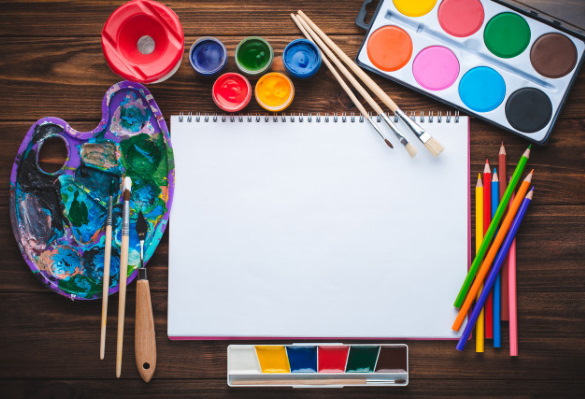
| Tools and materials | Brief description |
| Paper | For watercolor or gouache, thick paper is needed, and for graphic materials - thinner. For beginner artists, paper with a density of 200-300 g / m² is suitable. It differs in color and texture. |
| Graphite pencils | The softer the pencil, the richer the trace. Graphite pencils have a drier texture, they allow you to create precise and detailed drawings. They do not crumble, are easy to handle and easy to shade. Depending on the amount of graphite powder in the rod, they are hard (T, H), medium hard (TM, HB) and soft (M, B). |
| Charcoal pencils | Used to create deep, rich lines. Made from soft charcoal, which allows you to easily change the pressure and create different types of strokes. Charcoal pencils are suitable for sketching, can be used for detailing and shading. |
| Sanguine, sepia, sauce | Sanguine and sepia have warm, reddish-brown tones that blend and shade well on paper. These materials are ideal for sketching, quick sketches, and creating expressive lines and contours. They create a soft, warm effect that can be useful when drawing portraits, figures, and landscapes. Sauce provides a wide range of tones and textural effects. It is suitable for both fine, detailed images and abstract, expressive works. |
| Colored pencils | · Watercolor pencils allow you to achieve a watercolor effect on paper. They blend well. · "Professional" pencils have bright pigments, are durable and strong. These include brands: Faber-Castell Polychromos, Koh-I-Noor, Draeger. · Crayons differ in texture and appearance from pencils and are suitable for lines and strokes. · Acrylic colored pencils allow you to imitate acrylic paints. |
| Erasers | Designed to erase pencil lines, create highlights on the drawing and form shadows and halftones. They differ in softness and size. Rubber or rubber is used as a base. |
| Klyachki | These are soft tools for graphic work, made of eraser and other materials (for example, wood), have the shape of a bar and are used to lighten the drawing, connect tonal spots, soften contrasts and shade. Suitable for correction and creating a smooth transition between different areas of the drawing. |
| Stencils | It is a tool that involves using a template to apply repeating patterns. |
| Rulers, compasses | A ruler is a tool for determining and measuring the proportions and scale of an image. They can be used to draw clearer lines with a pencil. A compass is needed to measure distances and draw circles, as well as arcs and curves. Can be useful when creating symmetrical images. |
| Sharpeners | They serve to maintain the sharpness of the pencil lead. |
| Brushes | There are brushes for watercolor, gouache, acrylic and other paints. The quality of the brush depends on the material of the bristles (sheep wool, synthetics), shape (round, flat) and size. For example, to work with acrylic, you need a brush with synthetic bristles. |
| Gouache | It is a type of artistic paints made on a glue base. It has a high level of hiding power and a dense, saturated color. Gouache is convenient to work with due to its creamy texture. |
| Watercolor | The paint is diluted with water and creates light and airy transitions of tones. Watercolor allows the artist to use a wide palette of shades, making it a universal and diverse tool. |
| Acrylic | Unlike gouache and watercolor, acrylic paints dry quickly. This allows you to create clear and expressive lines. They allow you to mix colors in a picture without preparing a new shade. Acrylic lays well on any surface and is resistant to external influences. |
Master classes
To draw a planet in space, it is necessary to create a harmonious and convincing image that will provide proper visual perception.
Planets can be made with different materials and techniques. Space is an infinite space, so it is necessary to convey this feeling of spaciousness and depth.
Planets of the Solar System in Orbits in Pencil
There are 8 planets in the solar system.
They differ in size, weight, temperature and other characteristics:
- Mercury — the smallest planet in our system. It is located closest to the Sun, so the temperature there is very high. The surface is covered with craters from meteorite impacts and rocks made of rocks.
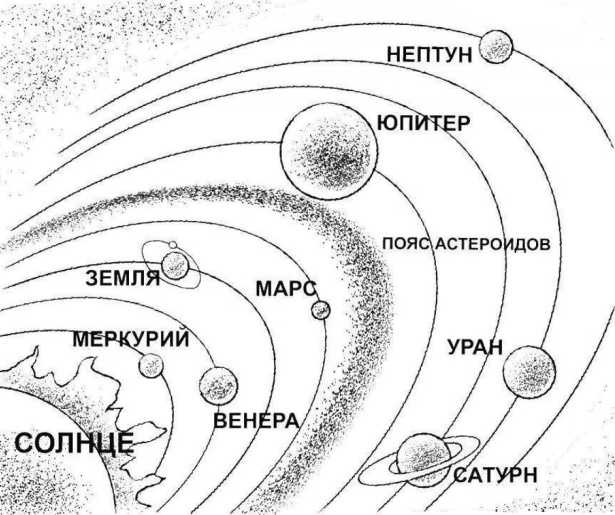
- Venus slightly larger than Mercury, is closer to Earth. It is covered in clouds, and its surface is entirely made up of volcanoes and mountains. Because of the dense cloud layer, Venus is always dark and very hot.
- On Earth favorable conditions for life have developed. There is an atmosphere, water and a moderate climate. The Earth is spherical, with mountains, plains and oceans.
- On Mars There are mountains higher than Everest and the largest volcano in the solar system - Olympus.
- The largest planets are located farther from the Sun: Jupiter, Saturn, Uranus and Neptune. They are made of gases and liquids, they have many satellites, and their rings are made of small particles of ice and rocks.
Planets in space can be depicted in a drawing using a step-by-step master class:
- Draw the basis for the solar system using light pencil lines and geometric shapes. Place the planets in their orbits relative to the Sun. Use a ruler or compass for this.

There is no need to strive for perfect accuracy - just create a general outline of the system.
- Place the Sun in the lower right corner of the drawing. This will help to distribute the space correctly and maintain compositional balance.
- Draw 8 lines (orbits) that will serve as a guide for the location of the planets. Use a ruler to make them even. Do not draw them too bright - they will be auxiliary elements.
- Distribute the planets by orbit. Mercury will be closest to the Sun, and Neptune will be the farthest. Follow the astronomical sequence: Mercury, Venus, Earth (with a small circle - the Moon), Mars and 4 giant planets: Jupiter, Saturn, Uranus and Neptune.
When distributing the planets, take into account the distance between them, maintaining the scale. Remember the correct location of each planet relative to the Sun: some of them may be in the shadow of the Sun (in this case, you can leave the area without shading).
- Between the orbits of Mars and Jupiter, depict the asteroid belt - a cluster of small celestial bodies. This can be several short curved lines.

When drawing the solar system with a pencil on a piece of paper, do not draw the details and textures of the planets, the Moon and the Sun. You need to focus on the overall picture, the orbits and the positions of the planets relative to each other and the Sun.
This method allows you to quickly and easily draw the main elements of the solar system without unnecessary details.
Saturn in colors
Saturn is one of the most beautiful planets in the solar system. It is famous for its rings, which consist of billions of particles of ice and dust. They surround the planet like a belt. Thanks to them, the surface of Saturn appears striped like a zebra.
Saturn is located 6th in distance from the Sun, so from Earth it can only be seen through a telescope or in photographs taken by spacecraft.
The planet is 95 times larger than Earth and its atmosphere is made up of hydrogen and helium. Because of its atmosphere, Saturn appears light and bright.

When depicting it, you will need to use many different shades, because the planet is constantly changing its color:
- Make a sketch of the future drawing. Determine the basic shapes and proportions of the planet and rings.
- Start drawing the planet. Use yellow and brown gouache tones to convey the color and texture of Saturn's surface. Start with the base tone, add darker and lighter shades to create volume. Maintain the overall color scheme.
- Draw rings around the planet using different shades of brown. The rings should be thin and transparent, as they are made of ice and dust. The shadow on the ring is closer to the planet.
- Continue working on Saturn's surface, adding new shades of yellow and brown. The transitions between colors should be smooth and natural. Use white for highlights on the clouds.
- Add different shades of brown to the ring pattern. This will help make them more varied and realistic. The outer side of the ring should be lighter than the inner side. Closer to the planet, the color should become darker and more saturated.
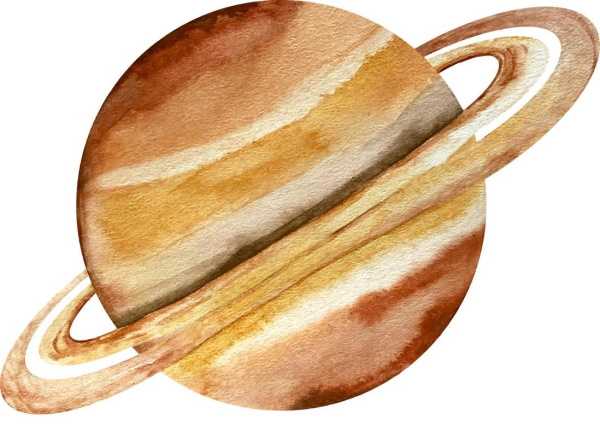
- Add a background in the form of a black starry sky. To do this, apply several large dots of dark blue or black color, which will symbolize stars. You can add several shimmering dots to create a glow effect.
- Draw additional stars on the background. They can be of different sizes and brightness.
Mars in paints
Mars is a planet in the Solar System, which is located 4th from the Sun. It has a reddish tint to its surface, which is why it is also called the "red planet". This is due to the presence of a large amount of iron oxide on Mars.
The planet has mountains, plains and volcanoes. Mars is famous for its canyons – Valles Marineris, which are the largest in the Solar System.
The surface of Mars is a desert with cold winters. The planet is not protected by a magnetic field like Earth, so solar radiation reaches the surface almost unchanged. The average temperature on the planet is about -63 °C.
The planets in space are depicted in the figure as follows:
- Make a sketch. To do this, outline the main contours of the planet and the space around it. This will help you see the overall composition and avoid drawing mistakes.
It is recommended to use simple geometric shapes (oval, circle), use a ruler and a simple pencil to create a clear outline.
- Take red paint as a base for the drawing. Use a medium-sized brush to apply the base color, making smooth transitions between shades. Start with the basic shape of Mars, using bright shades of red.
To make the planet more expressive, add half-shadows and highlights, creating the effect of surface relief. Use soft and dark tones for the main mass of the planet to give it a realistic look.
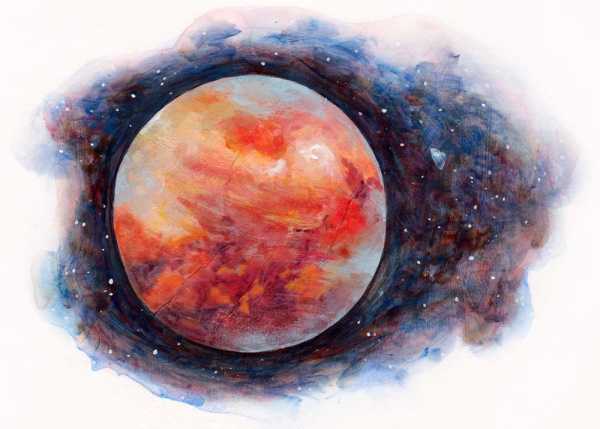
Add highlights to the brightest parts of the planet, creating the impression of a play of light and shadow. To add volume and texture, use a combination of different shades of red, from light to dark.
To depict craters, use light brush strokes, and for shadows, use short strokes.
- Pay special attention to the highlights. Use white or a very light shade of the primary red to create the effect of reflected light. Distribute the highlights over the most illuminated areas of the surface of Mars.
- Craters play an important role in creating a realistic look of Mars. They can be of different sizes and shapes. Use a dark shade of red or black to draw them. Add shadows to emphasize the volume of the craters.
- To create a cosmic atmosphere around the planet, draw a starry sky. Start with a dark background, gradually adding blue, red and purple shades to imitate stars. Use different sizes and shapes of stars to add depth and variety.
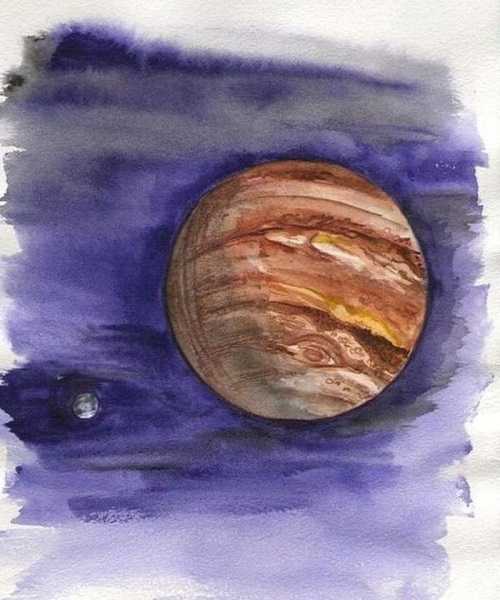
Draw the stars from the brightest ones, located closer to the planet, moving on to the dimmer ones and those further from the center.
- Add some blue and yellow-orange comets. They can have different shapes and sizes, so you need to experiment to find the right one.
Live in cartoon style with paints
Cartoon planets can be a fun and accessible way to present complex scientific information to children. The bright colors make them more memorable.
To create a drawing, you can use the following step-by-step master class:
- Create a sketch or outline that will serve as a basis. This can be a few simple lines that indicate the location of the planets and their main features.

- Apply 2 circles that will represent the planets. It is important that the circles are of different sizes and touch each other - this will create the impression of interaction between them.
- Add the following elements to the orange-red planet:
- 2 hands holding a microphone. More details such as fingers can be added.
- Open mouth, as if the planet is singing.
- Expressive eyes and eyebrows to give the planet character and emotion.
The yellow-gray planet with craters will look calmer and more thoughtful.
Add elements such as:
- Eyes that are partially closed by eyelids, creating a sense of contemplation. The gaze is directed at the singing planet.
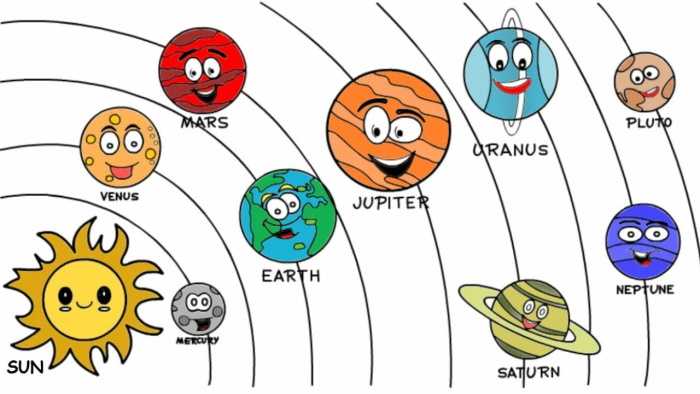
- A half smile that will express joy or satisfaction.
- Craters in grey paint on the surface.
Add a purple and black sky, strewn with stars (can be depicted as dots). This will create a space effect and add depth to the picture. The planets in space in the drawing can be supplemented with other elements, such as hair, to make the planets even more alive.
Unknown in the nebula with colors
The peculiarity of unknown planets is that they can differ significantly from those located in the Solar System, in size, mass, atmospheric composition and surface conditions. Planets in space in the picture can be drawn by following the following steps.
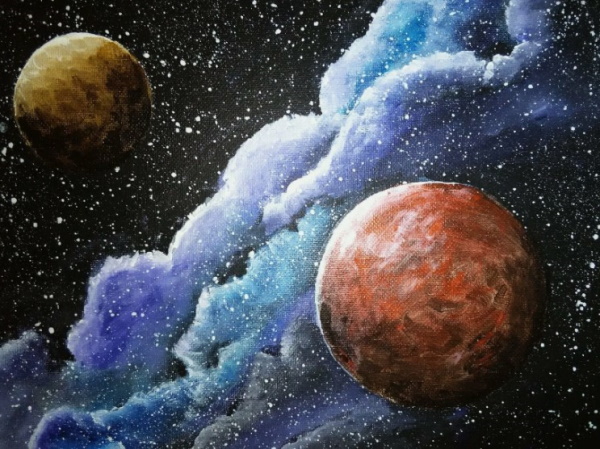
This master class is suitable for both beginner and more experienced artists:
- Start by creating a sketch of the future painting. Decide on the composition and location of the main elements: planet, nebula, stars.
A sketch will help you avoid mistakes when drawing further. Use a simple pencil to make it easier to correct the sketch. Keep the proportions and consider the perspective.
- Draw a planet. To do this, choose blue and draw its contours. It can be round, oval or even irregular in shape.
The planet should look three-dimensional, so you need to add shadows and light to create the effect of depth. Mountains, rivers, oceans and other landscape elements can make it unique.
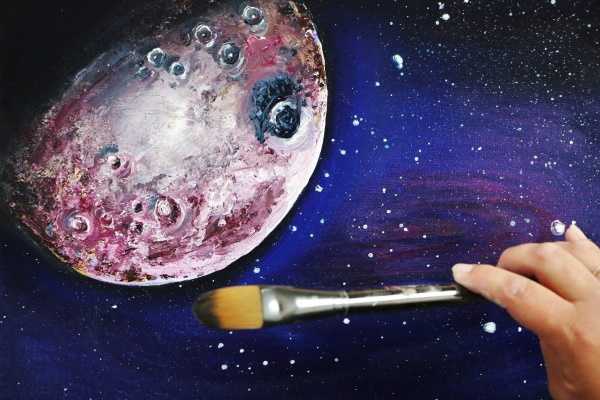
- To create a starry sky, use dark colors (black, blue) and bright colors for light areas. The sky should be uneven with different shades and halftones.
Use different brushes and shades of blue and black to create variety. Add shimmer or glitter to some of the stars.
- Form a nebula (a cloud made up of different shades of blue, black, and purple). You can experiment with textures and shapes to make it interesting. Nebulae can range from thin and delicate to dense and thick.
Tips for Beginners
It is necessary to master the basic elements and techniques that will help create a realistic and expressive drawing:
| Basic stage | Brief description |
| Select a planet | You need to decide on the planet that will be depicted. It can be similar to Earth or something fantastic and unnatural. Each planet has features that should be conveyed in the drawing. For example, Earth is bluish because of the oceans, and Mars is reddish. |
| Basics of composition | Drawing a planet involves understanding its location in space, which includes not only the size of the celestial body, but also its visual characteristics, such as color, brightness, and surface features. If you plan to draw a top view, you should place the planet below the center to get a sense of depth. To show its grandeur, you should place the celestial body in the center of the sheet. |
| Working out the planets | Planets usually consist of several basic elements: gas shells, solid surfaces, atmosphere. To provide variety and depth to the image, you can use various hatching and shading techniques, play with textures and gradients. |
| Visualization of the atmosphere | It can be drawn not only as a thin shell, but also as a dense environment with its own lighting and brightness characteristics. Shadows can be used to add depth and volume to the atmosphere, as well as to emphasize certain details of the planet's surface. |
| Lighting | It is necessary to consider what kind of lighting will fall on the surface. Thus, the Sun can look like a blinding disk or a shimmering glow at a great distance. There is a difference between daylight and nightlight, almost white and soft in the sky and more intense on the surface of the planet. Shades of blue and violet will appear in the shadows. Flashes from cosmic rays will emphasize the brightness of light areas. If the planet is sufficiently distant from its luminary and does not have its own light, it will be depicted in shades of gray and blue, sometimes black. |
| Volume effect | Space perspective allows you to emphasize the volume and shape of the planet, creating a sense of space and depth. This is achieved through the use of contrasts of light and shadow and the angles of the lines. To emphasize the volume, you can try using deep shadows, halftones and reflected light. |
| Space | It is important to consider the ratio of the scale of the planet and outer space. The celestial body should look small enough compared to the infinite space. Therefore, most often the planet is depicted as a small ball or disk. In the drawing, this should be emphasized by the difference in the elaboration of the foreground and background. The foreground can be made clearer and more detailed, the background – more blurred. |
Drawing planets located in space requires careful attention to detail and accurate reproduction of the visual characteristics of space.
Understanding the basic principles of construction, the use of light and shadow, and the proper use of materials and techniques will help you create expressive and realistic images.
Video about drawing
Planets in space - drawing:
